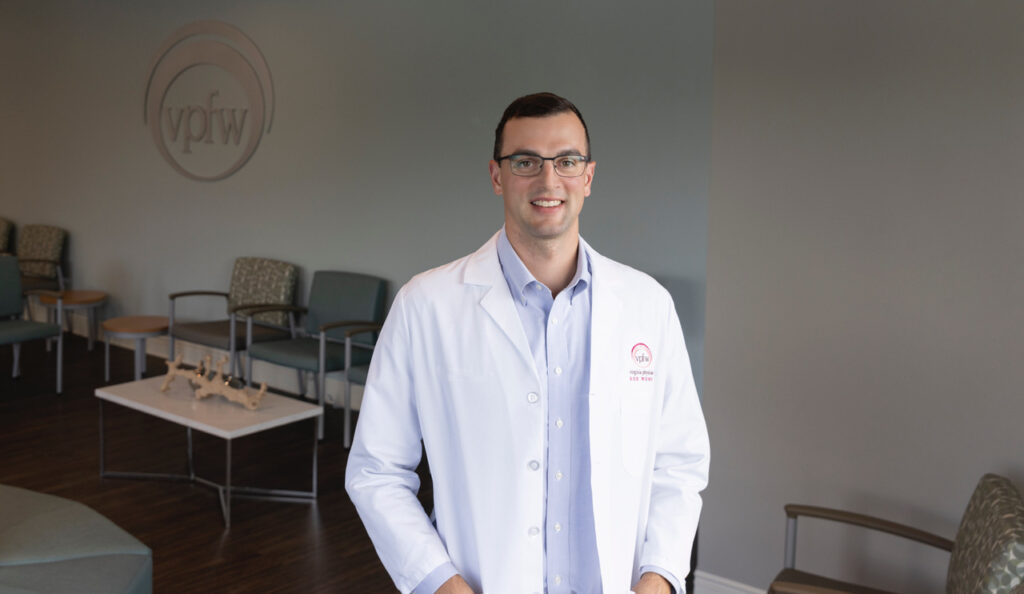Do you consistently experience pelvic pain – pain below your belly button and between your hips – that is worse than what your friends or other women in your family experience? Maybe your cycles have recently become much more painful than before. Or does your pain seem to occur all the time?
Pelvic pain, whether it has been going on for a few days or a few years, is one of the most common reasons women seek medical care. For women with pelvic pain symptoms, your OB/GYN is a great first place to start to help determine causes and treatments. Let’s talk about the top ten possible causes for pelvic pain and what you and your doctor can do about them.
1. Endometriosis
Endometriosis is a chronic gynecological condition that can affect women during their childbearing years. It is primarily caused by glands which are normally found within the uterus being implanted instead on tissues outside of the uterus, such as the ovaries, tissues surrounding pelvic structures, and even organs outside of the pelvis. Symptoms include chronic pelvic pain, sharp pelvic pain, severe menstrual cramping, painful intercourse, and infertility.
Approximately 10% of women are affected by endometriosis, and OB/GYNs are the specialists who treat this disease. While we don’t know the exact cause of endometriosis, we do have many treatment options that we can customize to a patient’s situation.
Endometriosis typically responds to hormonal treatments, but sometimes surgery is a required treatment. While surgery is the only way to confirm a diagnosis, we are often able to treat patients for suspected endometriosis without requiring surgery first. More good news about endometriosis: There are newly approved medications to treat the pain of endometriosis.
To learn more about endometriosis as well as a paid endometriosis clinical study being conducted at VPFW’s Koger Center office, check out Dr. Ingrid Prosser’s blog post, What You Can Do About Your Endometriosis-Related Pain And Infertility While Helping Others Who Suffer.
2. Adenomyosis
In some ways, adenomyosis is very similar to endometriosis. Adenomyosis occurs when the tissue lining of the uterus grows into the uterine wall causing the uterus to enlarge. We usually see this diagnosed in patients who are in their thirties or forties.
Painful periods, painful intercourse, and heavier-than-usual bleeding are typical symptoms.
Using ultrasound can often help with the diagnosis of adenomyosis. Hormonal medications are sometimes used for treatment. More often, surgery is the curative treatment, but only after a woman has decided to not have children.
3. Ovarian Cysts
Ovarian cysts are growths on or inside your ovaries. There are many types of ovarian cysts, and we see many different sizes of them. Most are not harmful and will go away on their own, but sometimes they can grow larger and cause complications. Once an ovarian cyst becomes around the size of lime, it can cause new, sometimes sharp pelvic pain.
Ovarian cysts are easily diagnosed with a pelvic ultrasound, which we can do in the office, to determine what kind of cyst may be affecting you. Some may require surgery. In rare cases, ovarian cysts can cause an emergency situation called ovarian torsion, in which an ovary becomes twisted around ligaments and connecting tissue. This condition causes severe pelvic pain and requires immediate care by your OB/GYN.
Having regular pelvic exams can help your provider spot ovarian cysts before they become problematic.

4. Pelvic Infections
STDs like gonorrhea, chlamydia, and trichomonas cause short-term pelvic pain that, if left untreated, can progress to long-term pelvic pain and cause pelvic inflammatory disease (an infection of a woman’s reproductive organs). In addition to these common infections, we now have a new test that can detect two different organisms responsible for chronic pelvic pain in women called mycoplasma and ureaplasma.
One vaginal test can screen for all these infections, and each has an antibiotic that is effective in treatment. Treating pelvic infections early decreases the risk of pain becoming long-lasting or chronic.
5. Irritable Bowel Syndrome
Your intestines or your GI tract can also be a source of pain in the pelvis. If your pain is related to a change in stool frequency or character that has been going on for several months, irritable bowel syndrome may be a cause. Your primary care doctor or a gastroenterologist can diagnose and recommend best treatments for this condition.
6. Inflammatory Bowel Disease
Inflammatory bowel disease is a more serious condition of chronic inflammation in the intestines. There are two main types: ulcerative colitis, which causes ulcers (sores) in the digestive tract, and Crohn’s disease, which causes swelling in the digestive tract.
Abdominal pain with bloody stools and diarrhea are common initial symptoms of inflammatory bowel disease. It can be diagnosed and treated by a gastroenterologist.
7. Interstitial Cystitis (Painful Bladder Syndrome)
Also known as painful bladder syndrome, interstitial cystitis is typically diagnosed in women in their forties or later, as opposed to endometriosis, which typically starts earlier in life. The condition causes pain and pressure in the bladder area and is commonly seen in patients who feel like they are constantly being treated for urinary tract infections, but the UTIs come right back after treatment. A urogynecologist is helpful at distinguishing this condition from other reasons for persistent bladder pain or blood in the urine.
8. Myofascial Pain
Myofascial pain refers to pain from muscles, ligaments, and tendons in the abdomen and pelvis. This type of pain is diagnosed during a visit to your OB/GYN office. We’re looking for abnormal muscle contraction or trigger points on the abdomen and in the pelvic floor muscles.
Myofascial pain is one of the most common causes of persistent pelvic pain and can be treated once identified. Physical therapy and medications are helpful, and sometimes injections can be utilized if initial therapies are not effective.
9. Pelvic Organ Prolapse
Lower pelvic pain that feels like pressure, a fullness sensation, or a feeling that something is falling out is usually caused by pelvic organ prolapse. Pelvic organ prolapse is a condition that occurs when the muscles and ligaments supporting organs inside a woman’s pelvis (such as the uterus, bladder, or rectum) weaken, causing the organ to fall into the pelvic floor. Often women describe feeling a bulge in their vagina or like they are sitting on a ball.
This is a very common cause of pelvic floor pain and can be diagnosed during a visit to the OB/GYN office. It’s commonly diagnosed years after childbirth, a hysterectomy, or menopause. Surgical and non-surgical treatments are available and are tailored to the person depending on the degree of prolapse and symptoms.
Two of our physicians specialize in treating prolapse and other pelvic floor disorders like urinary incontinence at the Urogynecology Center at VPFW.
10. Fibroids
Uterine fibroids are common, benign tumors of the uterus that often cause painful, heavier cycles or pelvic pressure and pain based on their size and location. Most women in their 40s have a small fibroid the size of a grape, which typically doesn’t cause symptoms or harm. But when fibroids become larger, they are common producers of pain.
A pelvic ultrasound is very good for diagnosing uterine fibroids, and there are medicines and surgeries that are effective for treatments. VPFW providers are some of the first in the area to conduct a new minimally invasive procedure to treat fibroids by dramatically shrinking them.
Don’t wait to seek treatment for pelvic pain.
If you’re experiencing pelvic pain, it’s important not to put off seeing your doctor. While there are certainly many more causes of pelvic pain that can be found by individual assessment, the above list gives a sense of what your OB/GYN may be considering during your appointment.
The sooner you receive diagnosis and care for pelvic pain, the better chance you have for successful treatment and preventing the problem from escalating. We also encourage you to stay on top of your annual exams so that your provider can spot potential causes of pelvic pain and take care of them before they become problematic. Whether your pelvic pain is something that will go away on its own or something that requires treatment, we’re ready to help you find answers and relief.
To schedule an appointment with a VPFW provider, you can call 804-897-2100 or set an appointment online.
About Garrett Wren, M.D.
Dr. Garrett Wren is an OB/GYN at Virginia Physicians for Women who sees patients at VPFW’s Koger Center and Prince George offices and delivers babies at Johnston-Willis Hospital. He is a Richmond native and currently lives with his family in the West End.







